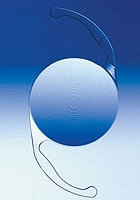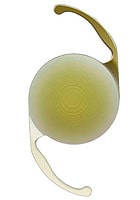Your eye has a clear lens through which light passes, allowing you to see. When the lens loses its transparency, the cloudy tissue that develops is known as a cataract.
Cataracts cause progressive, painless loss of vision. The lens clouds naturally as we age, so people over the age of 65 usually see a gradual reduction of vision. No one is exactly sure what causes cataracts. In younger people they can result from an injury, certain medications, or illnesses such as diabetes. Prolonged exposure to ultraviolet light may also play a role in the formation of cataracts. Studies have also shown that people who smoke cigarettes have a higher risk of developing cataracts than non-smokers.
Although cataracts usually develop without apparent pain, some indications that a cataract may be forming are:
- Blurred or hazy vision
- Double vision
- Poor vision in bright light
- Seeing halos around lights
- Poor vision at night
- Yellowish tinged vision
- Frequent changes in eyeglasses or contact lens prescription
Laser Precision in Cataract Surgery
The science of cataract surgery is getting better all the time. Innovative technology is available that matches the natural curvature of the human eye and is controlled by pressure sensors to optimize suction and reduce pressure during surgery.
Tradition Cataract Surgery
In traditional cataract surgery, your doctor uses a blade and then ultrasound, suction, and irrigation to break up and remove the cloudy lens to prepare the eye for the new clear lens.
Femtosecond Bladeless cataract Surgery
In blade-free laser cataract surgery, your doctor uses a laser beam to enter your eye and break up the cloudy lens for removal. Laser technology enables precision performance and the computer-guided accuracy of the laser complements your doctor's skills with today's latest technology.
Premium Lens Implants
If you have cloudy vision due to cataracts, intraocular lenses (IOLs) are an effective way to restore your vision. While standard IOLs correct your eyesight at only one distance, premium IOLs are designed to improve near and long-distance vision. This means patients, who choose a standard IOL, might still require glasses for reading or driving. Individuals that are interested in a more overall improvement can get a Premium IOL that will allow them to see clearly at near, mid, and long ranges. A Premium IOL may eliminate the need for visual aids altogether.
There are several different IOLs available to help each patient achieve the best possible results from his/her cataract surgery.

Multifocal IOLs
In the past, cataract lenses were only able to correct distance vision, often leaving patients with the need for reading glasses. Multifocal IOLs offer patients freedom from glasses after cataract surgery by improving vision at all distances and at any time of day. These lenses can quickly change focus to accommodate your vision needs. Up to 80 percent of patients do not need to rely on glasses with multifocal IOLs.

Toric IOLs
Toric IOLs are specifically designed for patients with astigmatism. In the past, patients with astigmatism would need eyeglasses or contact lenses even after cataract surgery in order to correct the problem. Toric IOLs such as AcrySof Toric corrects cataracts and astigmatism with just one lens, providing a more convenient and affordable solution to your vision needs.



